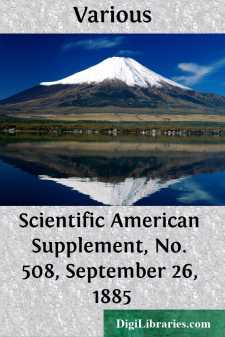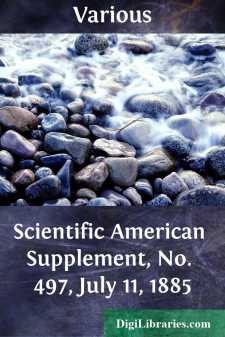Categories
- Antiques & Collectibles 13
- Architecture 36
- Art 48
- Bibles 22
- Biography & Autobiography 813
- Body, Mind & Spirit 142
- Business & Economics 28
- Children's Books 15
- Children's Fiction 12
- Computers 4
- Cooking 94
- Crafts & Hobbies 4
- Drama 346
- Education 46
- Family & Relationships 57
- Fiction 11828
- Games 19
- Gardening 17
- Health & Fitness 34
- History 1377
- House & Home 1
- Humor 147
- Juvenile Fiction 1873
- Juvenile Nonfiction 202
- Language Arts & Disciplines 88
- Law 16
- Literary Collections 686
- Literary Criticism 179
- Mathematics 13
- Medical 41
- Music 40
- Nature 179
- Non-Classifiable 1768
- Performing Arts 7
- Periodicals 1453
- Philosophy 64
- Photography 2
- Poetry 896
- Political Science 203
- Psychology 42
- Reference 154
- Religion 513
- Science 126
- Self-Help 84
- Social Science 81
- Sports & Recreation 34
- Study Aids 3
- Technology & Engineering 59
- Transportation 23
- Travel 463
- True Crime 29
Scientific American Supplement, No. 508, September 26, 1885
by: Various
Categories:
Description:
Excerpt
The use of electricity in the reduction of metals from their ores is extending so rapidly, and the methods of its generation and application have been so greatly improved within a few years, that the possibility of its becoming the chief agent in the metallurgy of the future may now be admitted, even in cases where the present cost of treatment is too high to be commercially advantageous.
The refining of copper and the separation of copper, gold, and silver by electrolysis have thus far attracted the greatest amount of attention, but a commercial success has also been achieved in the dry reduction by electricity of some of the more valuable metals by the Cowles Electric Smelting and Aluminum Company, of Cleveland, Ohio. Both this method of manufacture and the qualities of the products are so interesting and important that it is with pleasure we call attention to them as steps toward that large and cheap production of aluminum that the abundance of its ores and the importance of its physical properties have for several years made the unattained goal of many skillful metallurgists.
The Messrs. Cowles have succeeded in greatly reducing the market value of aluminum and its alloys, and thereby vastly extending its uses, and they are now by far the largest producers in the world of these important products. As described in their patents, the Cowles process consists essentially in the use for metallurgical purposes of a body of granular material of high resistance or low conductivity interposed within the circuit in such a manner as to form a continuous and unbroken part of the same, which granular body, by reason of its resistance, is made incandescent, and generates all the heat required. The ore or light material to be reduced—as, for example, the hydrated oxide of aluminum, alum, chloride of sodium, oxide of calcium, or sulphate of strontium—is usually mixed with the body of granular resistance material, and is thus brought directly in contact with the heat at the points of generation, at the same time the heat is distributed through the mass of granular material, being generated by the resistance of all the granules, and is not localized at one point or along a single line. The material best adapted for this purpose is electric light carbon, as it possesses the necessary amount of electrical resistance, and is capable of enduring any known degree of heat when protected from oxygen without disintegrating or fusing; but crystalline silicon or other equivalent of carbon can be employed for the same purpose. This is pulverized or granulated, the degree of granulation depending upon the size of the furnace. Coarse granulated carbon works better than finely pulverized carbon, and gives more even results. The electrical energy is more evenly distributed, and the current can not so readily form a path of highest temperature, and consequently of least resistance through the mass along which the entire current or the bulk of the current can pass. The operation must necessarily be conducted within an air-tight chamber or in a non-oxidizing atmosphere, as otherwise the carbon will be consumed and act as fuel. The carbon acts as a deoxidizing agent for the ore or metalliferous material treated, and to this extent it is consumed, but otherwise than from this cause, it remains unimpaired.
Fig. I. of the accompanying drawings is a vertical longitudinal section through a retort designed for the reduction of zinc ore, according to this process, and Fig....












